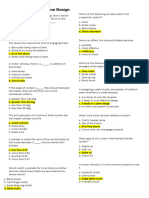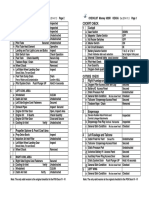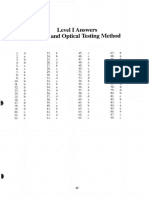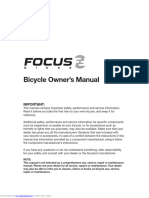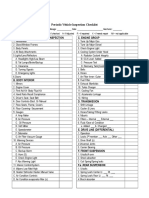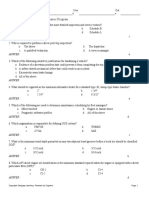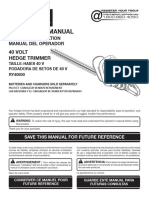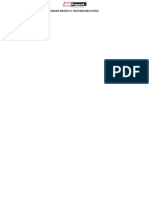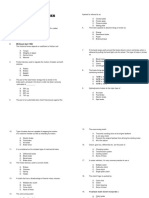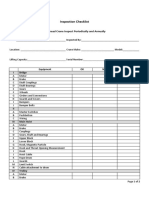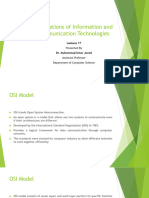Vehicle Pre-Trip Inspection: Section
Vehicle Pre-Trip Inspection: Section
Uploaded by
Budi KurniawanCopyright:
Available Formats
Vehicle Pre-Trip Inspection: Section
Vehicle Pre-Trip Inspection: Section
Uploaded by
Budi KurniawanOriginal Description:
Original Title
Copyright
Available Formats
Share this document
Did you find this document useful?
Is this content inappropriate?
Copyright:
Available Formats
Vehicle Pre-Trip Inspection: Section
Vehicle Pre-Trip Inspection: Section
Uploaded by
Budi KurniawanCopyright:
Available Formats
Section 5
Vehicle Pre-trip
Inspection
Professional Driver’s Manual • 107
Pre-trip Circle Check Illustration
When preparing for the pre-trip circle check practical examination you must study the indepth information
in the following pages.
1 Approaching the vehicle 4 Driving compartment
4 f
a. Vehicle body for damage a. Seat and seat belts
b. Under vehicle for fluid leaks b. Mirrors
c. Wheels blocked c. Windshield wiper and washer
d. Horn
2 Parking brake set e. Lights
f. Steering wheel free play
3 Under the hood g. Gauges and warning lights
a. Fluid levels h. Accelerator pedal
Power steering fluid i. Heater and defroster 4
Oil j. Windshield and
windows
Coolant
b
Windshield washer fluid
b. Drive belts
c. Radiator
d. Hoses and components b
e. Frame rails and cross members
b
3 a, b, d 3 2
6 a,b
3 d
c, d, e, f, g h, i, j k,l,m c, d, f, g c, d, f, g
7
6 Walk-around c. Tires i. Safety inspection
sticker
a. Grill and front bumper, licence d. Rims, spacers and fasteners
plate e. Hub oil j. Fuel tanks, brackets,
b. Headlights (high and low steps and caps
f. Suspension
beam), k. Batteries
springs
clearance lights, l. Exhaust system
mounting hardware
identification lights, m.Cab securement
suspension components
taillights, n. Load securement
air suspension system
stop lights, (air leaks) o. Side of vehicle for damage
side marker lights, g. Frame rails and cross members p. Rear tailgate/doors
licence plate light, h. Doors, windows, grab handles q. Underride protection
reflectors, and mirrors r. Landing supports
hazard lights and turn signals s. Sliding bogie locking bars
108 • Professional Driver’s Manual
4 g 5 Emergency equipment 5 a-c
a. Flags, flares or reflectors
b. Fire extinguisher
c. First aid kit
b b
g, v
q
b n, 0
g, r c, d, e, f, g c, d, e, f, g
6 f 7 Trailer hitch 7 a 7 b
a. Fifth wheel
b. Plate and kingpin
Professional Driver’s Manual • 109
Checking a vehicle before starting out, as required
Vehicle Condition by law, will often prevent costly delays as well as
Every driver of a commercial motor vehicle and some reduce the chances of an accident resulting from a
private use vehicles must carry out and log an inspection mechanical failure.
as outlined in The Highway Traffic Act and its Regulations.
Carrying out an efficient pre-trip inspection in
A commercial motor vehicle is:
a minimum of time can be done by drivers who follows
a. a motor vehicle with a GVWR of 4,500 kg or a systematic inspection.
more that is a public service vehicle or
For information on commercial motor vehicle and trailer
commercial truck;
trip inspections contact Transportation Regulation.
b. a bus with a seating capacity of 11 or more,
including the driver, that is used for
transportation of persons or property on
Pre-Trip Circle Check
a highway for gain or compensation; or Examination
c. a school bus. For Class 1, 2, 3 including pick-up trucks with a trailer
over 4540 kg’s and Class 4 (buses) the applicant will
The inspection will take place before the vehicle’s first
be required to complete a pre-trip circle check on the
trip of the day, and if a trip lasts more than one day,
vehicle they supply as part of the road test. During the
before the trip begins on the first day, and no later
pre-trip, the applicant must be able to locate, identify
than the first rest stop on the second and every
and check the items or components as set out in
subsequent day.
this manual. Inadequately completing the pre-trip
Regardless of the maintenance policies of companies and/or air brake inspection will result in the
or vehicle owners, all drivers must be capable of discontinuance and failure of the road test.
determining if their vehicle is in safe operating
An applicant is expected to complete the pre-trip circle
condition as outlined in The Highway Traffic Act
check in a systematic manner to conserve time.
and its Regulations.
The pre-trip inspection should take no more than
A person who carries out a vehicle pre-trip inspection
20 minutes to complete.
must make a trip inspection report in legible writing
that contains the following: Details of a pre-trip circle check will vary depending
on the vehicle being inspected, however, the principle
1. The licence plate number or unit number of
of making the pre-trip circle check should always
the vehicle and any trailer towed by it.
be followed.
2. The date of inspection.
If a vehicle is equipped with hydraulic brakes, an
3. A list of any safety defects. hydraulic brake system inspection as outlined in area H
at the end of this section, must be completed in
4. If no items are defective or required to be reported
conjunction with the pre-trip inspection.
on the vehicle or any trailer towed by it,
a statement to that effect. If a vehicle is equipped with air brakes, an air brake
inspection will be conducted in conjunction with the
5. The name and signature of the person who
pre-trip inspection. All applicants operating air brake
carried out the inspection.
equipped vehicles will be required to complete the air
If a driver believes or suspects that there is a safety defect brake system pre-trip inspection as outlined in the
they must report that belief or suspicion to the carrier. Air Brake Manual.
If the defect poses an unreasonable risk it must be
Note: When upgrading your driver’s licence from single
reported immediately. Any other case must be reported
to combination vehicles with air brakes, you will be
in a timely manner.
required to demonstrate the complete air brake steps for
Every commercial vehicle driver must have a current combination vehicles.
trip inspection report in their possession for the vehicle
Inadequately completing the pre-trip and/or air brake
and any trailer attached.
inspection will result in the discontinuance and failure
of the road test.
110 • Professional Driver’s Manual
All Vehicles Class 1, 2, 3, and Class 4 Buses
Inspect Inspection Method Report if
1. Approach vehicle and check:
1.1 Vehicle body for damage Visual Damaged.
1.2 Under vehicle for fluid leaks Visual Excessive fluid leaks.
2. Enter driving compartment and check:
2.1 Park brake is applied Visual Apply if not on.
3. Engine compartment, check:
3.1 Fluid levels to ensure adequate: Visual and Manual If levels are low fill adequately.
power steering fluid, oil, coolant
(do not remove radiator cap if hot),
transmission fluid, windshield washer fluid,
brake fluid if hydraulic brake system.
3.2 Drive belts for tension, cracking and wear. Visual and Manual Belt deteriorated or loose.
3.3 Radiator for leaks and security. Visual and Manual Leaks or loose.
3.4 Hoses and components for wear and leaks. Visual and Manual Leaks or deteriorated.
3.5 Frame rails and cross members for cracks Visual Insecure, cracked or broken.
and bending.
4. Driving compartment, check:
4.1 Seat and seat belt is adjusted and in Visually check that the seat Seat is damaged or distorted.
good shape. is anchored. Manually operate Seat fails to maintain selected
the seat and ensure adjustment adjustment. Any damage
is correct. Visually and that may reduce the
manually check seat belt effectiveness of the seat belt.
webbing and retractor
assembly.
Professional Driver’s Manual • 111
Inspect Inspection Method Report if
4.2 Turn key on: system check, start engine, Visual Warning lights or gauges
observe gauges and warning lights are not operating.
functioning properly.
4.3 Accelerator pedal for binding or sticking. Perform test with engine idling: Pedal binding; or engine will
depress accelerator pedal and not return to idle.
release.
4.4 Steering free play is not excessive. Visually and manually inspect Total movement greater than
with the engine running on shown in the following table.
vehicles equipped with power
Truck
steering. With the front wheels
in a straight ahead position, Steering wheel Steering lash
turn the steering wheel until Diameter power/manual
turning motion can be observed
Less than 50 mm/75 mm
at the front wheels, turn the
406 mm (16") (2.0")/(3.0")
steering wheel in the opposite
direction until motion can 406 mm to 75 mm/87 mm
be observed at the front wheels; 500 mm (3.0")/(3.5")
estimate the amount of steering (16")/(20")
lash. (Total movement observed
larger than 87 mm/100 mm
at steering wheel rim before
500 mm (20") (3.5")/(4.0")
movement at front wheel.)
Bus
less than 45 mm
300 mm
350 mm to 50 mm
400 mm
400 mm to 55 mm
450 mm
450 mm to 60 mm
500 mm
larger than 87 mm
500 mm
112 • Professional Driver’s Manual
Inspect Inspection Method Report if
4.5 Horn is working and audible. Activate system Horn fails to sound or is below
a reasonable audible level.
4.6 Windshield wipers and washer operation. Visual and Manual Windshield wipers fail to wipe
approximately 75% of the
windshield or contact the
windshield properly or return
to the “park” position.
Windshield washer fails to
apply solution to intended area
of the windshield.
4.7 Heater/defroster operation. Activate system Defroster motor fails to operate
in all selected positions.
Airflow over intended area
is not present.
4.8 Instrument lights are operational. Visual and Manual Not operating.
Turn signal indicators operational.
High beam indicator operational.
4.9 Condition and cleanliness of windows Visual Star or chip 12.7 mm (1/2") or
and windshield. greater in diameter; or any
intersecting cracks in glass
area, swept by windshield
wiper; or driver vision is
obscured or limited.
4.10 Adjustment and cleanliness of exterior Visual Insecure or obstructed or fails
and interior mirrors. to provide a clear view of
highway to the rear. Any mirror
that fails to maintain set
adjustment. Clouded as to
obscure vision.
5. Emergency equipment check:
5.1 Flags, flares or reflectors are present Visual Advanced warning device(s)
(if applicable). missing or broken.
5.2 Fire extinguisher is charged and stowed Visual Fire extinguisher missing
correctly (if applicable). or discharged (applicable
vehicles.)
5.3 First aid kit is present (if applicable). Visual First aid kit is missing or seal
broken (applicable vehicles.)
6. Outside checks:
6.1 Grill and front bumper are secure, Visual and Manual Loose or broken, plates
licence plate(s) valid and clean. not valid.
Professional Driver’s Manual • 113
Inspect Inspection Method Report if
6.2 Headlights (high and low beam), clearance Visually and manually inspect Any light is missing or
lights, identification lights, taillights, the operation of all the lights, broken or fails to illuminate
stop lights, side marker lights, licence plate except the hazard lights, with when its control device is
light, reflectors, reflective marking, hazard the vehicle engine running and actuated; or any lens or
lights and turn signals are operational the headlights, brake lights and reflector is broken,
and clean. all auxiliary lights illuminated; cracked or missing, reflective
inspect hazard lights with the markings missing.
ignition, headlights, brake lights
and auxiliary lights in the off
position, reflective marking
present on side and rear of
vehicle/trailer.
6.3 Front tires for cuts, bulges, air pressure, and Visual and Manual Any cords exposed due to
tread depth (not less than 3.2mm on front wear or damage; or evidence
steering tires). Rear tires for cuts, bulges, of tread separation or low air
air pressure, tread depth (not less than 1.6mm pressure. Insufficient tire
on rear tires), and no debris between dual tires. tread depth. Any abnormal
bump or bulge.
6.4 Mudflaps for security and condition. Visual Torn, insecurely mounted,
missing or not the full width
of the tire track. The lower end
of the mudflap is more than
than 350 mm (14") from the
ground.
6.5 Rims for cracks and slippage, spacers for Visual and Manual Rim bent, loose or cracked,
cracks or not seated properly, fasteners for or mounting holes elongated.
tightness, and hub oil level is adequate Spacers cracked or not seated
(if applicable). properly, fasteners loose,
missing, cross threaded or not
flush with the stud. Wheel or
lock rim assembly show signs
of cracking or severe damage.
Hub oil low.
6.6 Suspension for cracked or broken parts, Visually inspect for noticeable Broken springs or mounting
deflated or leaking airbags. sag or lean. hardware or deflated or
leaking airbag.
6.7 Frame rails and cross members for cracks Visual Insecure cracked or broken.
or bending.
6.8 Door(s), window(s), grab handles and mirror(s) Visual Insecure or obstructed; or fail
for security and provide a clear view. to provide a clear view.
6.9 Safety inspection decal is valid, clean and Visual No decal present or expired
visible (if applicable). decal.
114 • Professional Driver’s Manual
Inspect Inspection Method Report if
6.10 Fuel tank brackets or straps, steps and cap(s) Visual Cap missing, tank or lines
for security, and fuel lines for leaks. leaking or insecure.
6.11 Batteries for security and loose electrical Visual and Manual Loose.
connections.
6.12 Exhaust system and muffler for leaks Visually inspect with engine Any leaks.
and security. running.
6.13 Cab securement and suspension: Visually and manual inspect Cab not secure, air leak,
cab securely mounted, cab mounted (air pressure at normal air bag not inflated or bruised,
air bags and lines for leaks, shocks secure operating pressure). cab tilts to one side, shock
and not leaking. missing, broken leaking
or mounts loose.
6.14 Load securement, side and bottom doors, Visual and Manual Attachment points are cracked,
attachment points and securement elongated or broken.
equipment (chains, wire rope, webbing Securement equipment is
hooks, binders, etc.) stretched, cracked, broken or
inadequate strength or
insufficient tie-down
assemblies.
6.15 Sides of vehicle for damage or load for shifting Visual Any exterior body panel that
(if applicable). is damaged or deteriorated so
that it constitutes a hazard.
Any compartment door that
is loose or has missing or
detached holding fixtures.
Load must be properly secured
before moving.
6.16 Rear tailgate/door(s) securely closed. Visual If cannot securely close.
6.17 Underride protection or rear bumper is secure Visual Insecure, broken or protruding
(if applicable). and is hazardous.
Footnote: For vehicles with hydraulic brakes see section H. Buses see section 8.
7. Additional checks for Combination Vehicle:
7.1 Fifth wheel: The trailer is sitting properly on Visual Cracked or insecurely
the fifth wheel, the locking handle is locked mounted; any weld that
and the fifth wheel jaws are locked around the is broken or latch lock that
kingpin of the trailer. Fifth wheel slide locks is inoperative, or eye or lunette
are fully locked and not damaged. Connections worn more than 9.5 mm (3/8").
other than fifth wheel: coupling devices are
locked and securely mounted, all safety chains
are attached securely.
7.2 Electrical cord is properly connected, Visual Insecure, broken or protruding
in good condition and stowed properly. and is hazardous.
7.3 Trailer safety inspection decal is valid, Visual No decal present or expired
clean and visible, (if applicable). decal.
Professional Driver’s Manual • 115
Inspect Inspection Method Report if
7.4 Landing supports are in the up position and Visual Place in the up position and
the crank handle is stowed properly. Check stow handle correctly. Any
for any damage to the loading supports damage.
and structure.
7.5 Sliding bogie locking bars or pins are secure Visual Locking bars or pins are
and not damaged. not secure or damaged.
7.6 Spare tire for security and condition Visual Not secure or condition (see 6.3).
(if applicable).
7.7 Trailer licence plate for validity. Visual Licence not valid.
8. Additional checks for Buses:
8.1 All interior lights are operational. Visual Not working.
8.2 Aisle and stairwell lights are operational. Visual Not working.
8.3 Passenger seats and handrails for security. Walk the full length of the Any seat or attaching fixture
interior of the bus, observe seat that has a defect that may
assemblies and attaching fixtures constitute a hazard to any
as well as stanchion bars. person. Any stanchion bar
that is not attached in its
intended receptacle and
presents a hazard to any person.
8.4 Emergency exits and warning buzzer are Visual and Manual Visibly damaged or not
operational from inside and outside working.
(if applicable).
8.5 Service door control is functional. Activate entrance and exit door Any door that fails to function
control mechanism. as intended. Brake or
brake/accelerator interlock
system fails to function as
intended. Interlock system fails
to release when doors are
closed and locked.
8.6 Additional auxiliary heaters or Manual Does not blow air in desired
air conditioners are operational. location.
116 • Professional Driver’s Manual
Inspect Inspection Method Report if
8.7 Interior condition of bus, floor, dash, steps, Visual Interior body panels are
windows and operator’s compartment. damaged and present a hazard
to any person. Floor is damaged
or worn and presents a hazard
to any person. Dash area has
defects that present a hazard to
any person. Steps are not clean
and in good condition to
prevent tripping or slipping.
Windows are not free from
cracks or damage that may
present a hazard to any person.
Window latches and emergency
release hardware are not
present or in good condition.
Operator’s compartment has
defects that may cause a hazard
to the operator.
8.8 Wheelchair lift and kneeling feature or wheel With engine running, cycle Audible alarm fails to function.
chair ramp are operational, (if applicable). wheelchair lift, lower and raise Lift safety devices fail to
kneeling bus or deploy ramp. function as intended. Lift
does not complete cycle.
Interlock system fails to
activate and release as
intended. Bus does not return
to level position after kneeling.
8.9 Wheelchair restraints are operational and Visual and Manual Restraint missing or
secure, (if applicable). inoperative.
Hydraulic brake system inspection
Complete the brake check for vehicles with hydraulic brake system, as follows:
H.1 Electric motor (brake assist) With the vehicle engine stopped, Electric motor fails to operate.
(if applicable) apply moderate pressure to the
service brake pedal, electric motor
operating should be audible.
H.2 Vacuum boost operation (if applicable) With the engine stopped, depress Brake pedal fails to move.
the service brake pedal several
times to eliminate vacuum, then
with light foot pressure on the
pedal (12 kg or 25 lbs) start the
engine.
Professional Driver’s Manual • 117
Inspect Inspection Method Report if
H.3 Brake warning indicator Visually inspect and apply service Brake warning indicator lamp
(with parking brake released) brake pedal. operates continuously or when
brake is applied.
H.4 Brake pedal reserve Test with the engine running if Pedal moves towards the floor
the vehicle is equipped with more than 65%.
power brakes; apply and maintain
a moderate foot force to the service
brake pedal for one minute.
H.5 Park brake Apply parking brake and, with Park brake fails to hold vehicle.
engine running at an idle and
the transmission engaged,
attempt to move the vehicle.
H.6 Brake performance Move the vehicle forward and Brake pull exists or brake
apply the service brakes. Also performance appears to be
move vehicle ahead and less than adequate.
apply electric trailer brakes
(if applicable).
118 • Professional Driver’s Manual
NOTES:
Pre-trip Circle Check
• If a vehicle is equipped with air brakes,
Tear Out Sheet an air brake inspection will be conducted in
You may use this checklist for your test. Do not add to, conjunction with the pre-trip inspection. All
or write on this form. If altered it cannot be used on applicants operating air brake equipped
the test. The Professional Driver’s Manual has specific vehicles will be required to complete the air
inspection information that must be studied prior to brake system pre-trip inspection as outlined
the test. in the Air Brake Manual.
• When upgrading your driver’s licence
Key points:
from single to combination vehicles with
• You need to locate the items to be checked and air brakes, you will be required to
tell the examiner how and what you check on demonstrate the complete air brake steps
that part. Never assume the examiner has enough for combination vehicles.
information and delete items. When the examiner
Inadequately completing the pre-trip and/or
is satisfied in your knowledge of the area you may
air brake inspection will result in the
be asked to move along.
discontinuance and failure of the road test.
• The pre-trip inspection should be done in
a systematic manner to conserve time. This
pre-trip should take no more than 20 minutes
to complete.
• If using a trailer with electric brakes, the system
must be inspected to ensure it is operating properly.
✄
Professional Driver’s Manual • 119
All Vehicles Additional Checks for
• Approach vehicle Combination Vehicles
• Vehicle secure • Fifth wheel/coupling device
ENGINE COMPARTMENT • Air lines, glad hands and electrical cord
• Fluids • Landing supports and crank handle
• Drive belts, hoses • Sliding bogie locking bars/pin (if applicable)
• Batteries
• Frame rails and cross members
Additional Checks for Buses
• Interior lights
DRIVING COMPARTMENT (IN-CAB)
• Seats and handrails, wheel chair restraints
• Controls
(if applicable)
EMERGENCY EQUIPMENT (if applicable) • Emergency exits (if applicable)
OUTSIDE CHECKS • Service door(s)
• Bumpers • Auxiliary heaters (if applicable)
• Lighting equipment • Wheelchair lift or kneeling feature (if applicable)
• Tailgate, doors, mirrors, load
• Safety sticker
• Licence plates
• Fuel tank
• Exhaust system
• Tires
• Rims
• Suspension
• Splash guards
• Hub oil (if applicable)
HYDRAULIC BRAKE INSPECTION
(non air brake vehicles only at this point)
120 • Professional Driver’s Manual
In-Service Inspections Pre-Hill Inspection
In addition to the pre-trip inspection, trucks and trailers Anytime a sign is posted that requires truck drivers to
should be inspected at regular intervals throughout the stop in the pull-out area and inspect their brakes
trip. The driver should stop the vehicle clear of the before proceeding down the steep hill ahead, drivers
travelled portion of the highway and check: must comply.
• wheel lugs and nuts; Before proceeding down the grade, truck drivers
equipped with air operated braking systems must check:
• tires for condition, pressure and overheating;
• compressor is maintaining full reservoir pressure;
• hubs and drums for heat;
• slack adjusters for push rod travel and take up
• brakes for operation (See Air Brake Manual);
slack if required, and you are authorized in
• coupling devices; slack adjustment;
• load security; • check for air leaks;
• drive lines and oil leaks; • security of glad hands and lines;
• lights and windshield visibility; • drums for overheating;
• record an in-service inspection in the log book. • emergency valve operation.
Truck drivers equipped with hydraulic brake systems
Post-Trip Inspection will check:
At the end of the final trip of the day you must conduct • pedal reserve;
a post-trip inspection on your vehicle. This inspection is
• vacuum booster operating;
similar to a pre-trip inspection. During this inspection
you must check for any damage or defects that may have • drums for over-heating;
developed on your vehicle during the trip. You must also
• visual inspection for hydraulic fluid leaks.
complete a post-trip inspection report. This report must
note any defects found during the post-trip inspection. You must stop and check your brakes when this sign
The post-trip inspection can be added to the report you is posted.
completed during the pre-trip inspection at the start
of that day.
If the vehicle is equipped with air brakes, see the
Air Brake Manual for additional items to be inspected
during the post-trip inspection.
Professional Driver’s Manual • 121
Notes
122 • Professional Driver’s Manual
You might also like
- CMRT Practice QuestionsDocument2 pagesCMRT Practice Questionslinbaba123100% (2)
- Boeing 737-300 Transit CheckDocument6 pagesBoeing 737-300 Transit CheckUmer JavedNo ratings yet
- 2015 02 Fall Protection Test and Answer KeyDocument2 pages2015 02 Fall Protection Test and Answer KeyR.Ranjan PradhanNo ratings yet
- Sample Maintenance Sheet: TrailerDocument2 pagesSample Maintenance Sheet: TrailerTris50% (2)
- Crawler Crane Inspection ReportDocument9 pagesCrawler Crane Inspection ReportAdvent ManurungNo ratings yet
- BMTDSL Submarine Concept Design DatasheetDocument2 pagesBMTDSL Submarine Concept Design DatasheetTheyaga GanesanNo ratings yet
- ME134-Internal Combustion Engine (Syllabus-Same Grade With Class Record)Document4 pagesME134-Internal Combustion Engine (Syllabus-Same Grade With Class Record)Yohan ManaligodNo ratings yet
- Form Checklist Inspeksi Hoist CraneDocument1 pageForm Checklist Inspeksi Hoist CraneM AzharNo ratings yet
- ENR - FM.HSE.16 Hoise CraneDocument1 pageENR - FM.HSE.16 Hoise CraneEKO PRIBADINo ratings yet
- Annual Vehicle Inspection Report TemplateDocument1 pageAnnual Vehicle Inspection Report TemplateAdolphe HotereshiNo ratings yet
- Inspection ChecklistDocument2 pagesInspection ChecklistBerp OnrubiaNo ratings yet
- Annual Vehicle Inspection ReportDocument1 pageAnnual Vehicle Inspection ReportjakonazerNo ratings yet
- 2020-Mip-Inspection-Electronic-Form 2 PDFDocument2 pages2020-Mip-Inspection-Electronic-Form 2 PDFtoddNo ratings yet
- E-Test: ST ND RD THDocument2 pagesE-Test: ST ND RD THneneng hernawatiNo ratings yet
- Student Skill Promotion Test: Automotive MechanicDocument12 pagesStudent Skill Promotion Test: Automotive MechanicCinta Tak BertuanNo ratings yet
- Vehicle Inspection Form 01Document1 pageVehicle Inspection Form 01GuruNo ratings yet
- Medicine EmpireDocument4 pagesMedicine EmpirenyahegomohammedNo ratings yet
- Ceph+SB+7 25 12 RedDocument1 pageCeph+SB+7 25 12 RedOliver MladenovskiNo ratings yet
- Removal and InstallationDocument10 pagesRemoval and InstallationPetr LisoňNo ratings yet
- Instruction Manual: For Alt-Azimuth MountDocument16 pagesInstruction Manual: For Alt-Azimuth MountJimy Unfried-SilgadoNo ratings yet
- APS-Form Cutting Torch & Welding Equipment Inspection - RevisedDocument2 pagesAPS-Form Cutting Torch & Welding Equipment Inspection - ReviseddvggfdhdbdfvbNo ratings yet
- Level I Questions Visual and Optical Testing MethodDocument30 pagesLevel I Questions Visual and Optical Testing MethodAndres TorresNo ratings yet
- PRO - ECO1 - S8-G1 - 14-18 JuinDocument349 pagesPRO - ECO1 - S8-G1 - 14-18 JuinCHALABI FARES100% (1)
- National Certificate in Automotive MachanicsDocument63 pagesNational Certificate in Automotive MachanicsMuwonge StephanoNo ratings yet
- API 510 Api 510 - Closed - CLOSED-6 6Document4 pagesAPI 510 Api 510 - Closed - CLOSED-6 6jhover graosNo ratings yet
- Sample Questions: Answer Key: 1-C, 2-B, 3-C, 4-B, 5-A, 6-BDocument2 pagesSample Questions: Answer Key: 1-C, 2-B, 3-C, 4-B, 5-A, 6-BAbdo JondiNo ratings yet
- Q3 Compiled ElementsDocument5 pagesQ3 Compiled Elementschuapril681No ratings yet
- KOn. Keahlian XI TKRODocument2 pagesKOn. Keahlian XI TKROJuli Hardo Purba TanjungNo ratings yet
- Mooney M20R - ChecklistDocument14 pagesMooney M20R - ChecklistJoão SantosNo ratings yet
- Checklist Alat BeratDocument1 pageChecklist Alat Beratarin ALPNo ratings yet
- 300 Verado Fourstroke Verado Closed Compartment Technology (CCT) Installation and Owners Manual SupplementDocument13 pages300 Verado Fourstroke Verado Closed Compartment Technology (CCT) Installation and Owners Manual SupplementNoman RasheedNo ratings yet
- NECO Auto Mechanical Work Past Question Paper and Answer PDF DownloadDocument10 pagesNECO Auto Mechanical Work Past Question Paper and Answer PDF DownloadCharles Obaleagbon50% (2)
- Up 3Document5 pagesUp 3tufailNo ratings yet
- Visual Nivel 1 2 y 3pdf PDF Free (1) (14 33)Document20 pagesVisual Nivel 1 2 y 3pdf PDF Free (1) (14 33)moussaguisse21No ratings yet
- BicycleDocument36 pagesBicycle9j97ctrw5gNo ratings yet
- EXAMEN DE SUBSANACIÓN - PDF Dic 22 NewDocument4 pagesEXAMEN DE SUBSANACIÓN - PDF Dic 22 NewBrayan ChiquezNo ratings yet
- Akes and Clutches T13Document6 pagesAkes and Clutches T13devera reynaldNo ratings yet
- 2015 02 Fall Protection Test and Answer KeyDocument4 pages2015 02 Fall Protection Test and Answer Keysayedattafsiddique7No ratings yet
- EHA CHECK LIST - Machine Fitness: Job Data Site Data Machine DataDocument3 pagesEHA CHECK LIST - Machine Fitness: Job Data Site Data Machine DataHari Hara SuthanNo ratings yet
- Sample: Excavator Safety TrainingDocument61 pagesSample: Excavator Safety Trainingvega f anka100% (1)
- Mtbalt 1Document38 pagesMtbalt 1Nelson VillateNo ratings yet
- English 3: Unit 5: Buying A Car Online Session 1Document13 pagesEnglish 3: Unit 5: Buying A Car Online Session 1Bryan Nick Espinal LadosNo ratings yet
- Preventive Maintenance ChecklistDocument3 pagesPreventive Maintenance ChecklistDominador J. Santos Jr.No ratings yet
- Car-Pre Delivery Inspection v2 - 3Document4 pagesCar-Pre Delivery Inspection v2 - 3manav SinglaNo ratings yet
- Chapter 04 Preventive Maintenance ProgramDocument6 pagesChapter 04 Preventive Maintenance ProgramRajvir GrewalNo ratings yet
- Model DE Electronically Controlled Diesel Fuel Injection Pump Operation and Instruction ManualDocument60 pagesModel DE Electronically Controlled Diesel Fuel Injection Pump Operation and Instruction ManualjiovanniNo ratings yet
- Booms Pre-Delivery ChecklistDocument1 pageBooms Pre-Delivery ChecklistOzlem MepNo ratings yet
- Luxfer SOPMPV Manual Rev 3bDocument16 pagesLuxfer SOPMPV Manual Rev 3bandreicarbuneanuNo ratings yet
- Check List Inspeccion Frame - 798 AcDocument2 pagesCheck List Inspeccion Frame - 798 AcPaola Uriol CerquinNo ratings yet
- 1/10 4Wd Nitro Monster TruckDocument12 pages1/10 4Wd Nitro Monster Truckjaredesilva92No ratings yet
- 25 - VT Q&a 1-3Document38 pages25 - VT Q&a 1-3Ameem TariqNo ratings yet
- CP690 Cotton Picker Maintenance and Cleaning GuideDocument20 pagesCP690 Cotton Picker Maintenance and Cleaning GuideFélix lucio ChozempaNo ratings yet
- Hur Co DrawingsDocument22 pagesHur Co DrawingsdullecncNo ratings yet
- Ryobi 40 Volt Hedge Trimmer ManualDocument34 pagesRyobi 40 Volt Hedge Trimmer ManualqfmdvqbsyzNo ratings yet
- Jomar Product TroubleshootingDocument2 pagesJomar Product TroubleshootingWasim AbbasNo ratings yet
- Brakes and Clutches T13Document6 pagesBrakes and Clutches T13SkylarNo ratings yet
- Inspection Checklist-Over Head CraneDocument2 pagesInspection Checklist-Over Head CraneWalid DarwishNo ratings yet
- Removal & Assembly: 1. Paper Feed Tray UnitDocument9 pagesRemoval & Assembly: 1. Paper Feed Tray UnitRheana DomingoNo ratings yet
- FCJJ-31 User ManualDocument8 pagesFCJJ-31 User ManualArun KumarNo ratings yet
- EXAMEN DE RECUPERACIÓN TRACTOR ORUG AaaDocument2 pagesEXAMEN DE RECUPERACIÓN TRACTOR ORUG AaaFresciaColquehuancaGonzalesNo ratings yet
- GM5 (B) Pacino Intel Discrete & UMA Block DiagramDocument62 pagesGM5 (B) Pacino Intel Discrete & UMA Block DiagramCarlos Costa100% (1)
- 5992-2013EN Nemo Outdoor TEDocument31 pages5992-2013EN Nemo Outdoor TEHrvoje ErorNo ratings yet
- Title: Smart Health Care Problem StatementDocument3 pagesTitle: Smart Health Care Problem StatementVishwanath DesaigoudarNo ratings yet
- Quick Manual For Pro100Document21 pagesQuick Manual For Pro100Daniel StamenkoskiNo ratings yet
- MN006055A01-AA Enus MOTOTRBO Customer ProgrammingDocument651 pagesMN006055A01-AA Enus MOTOTRBO Customer ProgrammingOscar EscobarNo ratings yet
- DBMS Unit-1 PPT 1.2 (Advantages & Disadvantages of DBMS, Components, Overall System Tructure)Document5 pagesDBMS Unit-1 PPT 1.2 (Advantages & Disadvantages of DBMS, Components, Overall System Tructure)lightNo ratings yet
- Congestion Recognition in Mobile Networks: Rami AlisawiDocument62 pagesCongestion Recognition in Mobile Networks: Rami AlisawitadeleNo ratings yet
- Realization of Control System Concepts Using Matlab and SimulinkDocument4 pagesRealization of Control System Concepts Using Matlab and Simulinkvijay81541No ratings yet
- ION-CEDI-BR Ion PureDocument8 pagesION-CEDI-BR Ion PureAndri YantoNo ratings yet
- DC - Experiment - No. 4Document9 pagesDC - Experiment - No. 4amol maliNo ratings yet
- Laptop Buying Guide PDFDocument5 pagesLaptop Buying Guide PDFJohn CenaNo ratings yet
- Catatan Tugasan Harian Ft19 Fa29 2017Document1 pageCatatan Tugasan Harian Ft19 Fa29 2017Nurul Nadia KamarudinNo ratings yet
- Emb Lab Manual FinalDocument142 pagesEmb Lab Manual FinalSatheesh Kumar100% (1)
- Lab - 01 DFA SimulationDocument4 pagesLab - 01 DFA SimulationSR ReliabilityNo ratings yet
- ICT Lecture 17Document16 pagesICT Lecture 17Muhammad UmarNo ratings yet
- Multi-Carrier HSDPA (RAN17.1 02)Document247 pagesMulti-Carrier HSDPA (RAN17.1 02)riamaNo ratings yet
- Establishment User ManualDocument29 pagesEstablishment User ManualAzharNo ratings yet
- Unit Iii Statistical Process Control and Process CapabilityDocument26 pagesUnit Iii Statistical Process Control and Process CapabilityDurai Raj KumarNo ratings yet
- Inteligent Field InstrumentsDocument4 pagesInteligent Field InstrumentsmarcalpiNo ratings yet
- Markview Scanning and Oracle PayablesDocument6 pagesMarkview Scanning and Oracle Payablesprabhakar_reddy_1No ratings yet
- Chapter 6: InternetDocument3 pagesChapter 6: InternetMustafa RadaidehNo ratings yet
- Software License Terms For Microsoft Report BuilderDocument2 pagesSoftware License Terms For Microsoft Report Builderlojio9627No ratings yet
- Control Systems Training - Session 01: Introduction To Industrial AutomationDocument31 pagesControl Systems Training - Session 01: Introduction To Industrial AutomationUmaNo ratings yet
- Difference Between Dry Type Transformers VsDocument4 pagesDifference Between Dry Type Transformers Vsmilad rouhiniaNo ratings yet
- Comment - Mouda - R0 - VFD Data SheetDocument34 pagesComment - Mouda - R0 - VFD Data SheetAshok reddyNo ratings yet
- What Is Technical WritingDocument7 pagesWhat Is Technical WritingEmyNo ratings yet
- Understanding and Using Web ADI in Oracle HRMS (ID 360105.1)Document17 pagesUnderstanding and Using Web ADI in Oracle HRMS (ID 360105.1)Saquib Mahmood0% (1)
- System 300 Modular Plants: Terex Minerals Processing Systems System 300Document2 pagesSystem 300 Modular Plants: Terex Minerals Processing Systems System 300gambit galihNo ratings yet


























